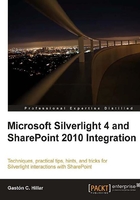
Preface
Silverlight is a powerful development platform for creating engaging, interactive user experiences for web, desktop, and mobile applications. Integrating Silverlight RIAs in SharePoint 2010 offers amazing opportunities to combine the power and flexibility offered by SharePoint. It is easy to create great user experiences when you have a step-by-step guide to implement Silverlight 4 applications on SharePoint 2010 sites, isn't it?
This book begins with the fundamental concepts of integrating Silverlight 4 with SharePoint 2010, such as the preparation of the development environment to create applications using Silverlight 4 and the addition of one or more Silverlight RIAs to a SharePoint site.
Then, it moves into the SharePoint Silverlight Client Object Model world, using step-by-step examples to combine a Silverlight application and a SharePoint module. It explains to deploy and debug the Silverlight application while it runs as s Silverlight Web Part in a SharePoint page.
Then, it is time to interact with SharePoint lists to perform CRUD (Create, Read, Update, and Delete) operations and retrieve metadata information for the fields that compose lists. The book teaches to take advantage of the new features offered by Visual Studio 2010 to browse SharePoint lists.
Once you have control over the SharePoint Silverlight Client Object Model and its asynchronous operations in Silverlight applications, it is time to access external databases through the new Business Connectivity Services (BCS) and interact with workflows. Then, the book explains how to perform CRUD operations by consuming the new SharePoint 2010 WCF Data Services in Silverlight.
Then, consuming different kinds of multimedia files from the new SharePoint 2010 Digital Asset Libraries offers the final touches to the Silverlight 4 and SharePoint 2010 integration learning experience.
In each example, the book teaches to take advantage of unique features offered by Silverlight in order to create impressive User eXperiences that interact with SharePoint 2010. For example, themes, effects, animations, data-binding, and Silverlight 4 Out-of-Browser capabilities.